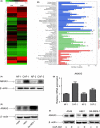Cancer-associated fibroblasts contribute to cisplatin resistance by modulating ANXA3 in lung cancer cells
- PMID: 30868675
- PMCID: PMC6500998
- DOI: 10.1111/cas.13998
Cancer-associated fibroblasts contribute to cisplatin resistance by modulating ANXA3 in lung cancer cells
Abstract
Cancer tissues consist of cancer cells, surrounding stromal cells and the extracellular matrix. Cancer-associated fibroblasts (CAF) are one of the key components of stromal cells. CAF have a great impact on the behavior of cancer cells, including proliferation, invasion, metastasis and chemoresistance in many ways. However, the underlying mechanism had not been fully elucidated. In this study, we investigated the role of CAF in cisplatin resistance of lung cancer cells. By using conditioned medium from CAF (CAF-CM), we found that CAF decreased the sensitivity of lung cancer cells to cisplatin. RNA sequencing results showed that CAF expressed a higher level of Annexin A3 (ANXA3) than normal fibroblasts (NF), and CAF-CM incubation increased the ANXA3 level in lung cancer cells. Overexpression of ANXA3 in lung cancer cells increased cisplatin resistance and activated c-jun N-terminal kinase (JNK), whereas knockdown of ANXA3 increased cisplatin sensitivity. Further study showed that CAF-CM enhanced cisplatin resistance by inhibiting cisplatin-induced apoptosis, determined by repression of caspase-3 and caspase-8, through activation of the ANXA3/JNK pathway. Conversely, suppression of JNK activation by specific inhibitor retarded the effect of CAF-CM and ANXA3 on cisplatin sensitivity. Taken together, our study demonstrated that CAF potentiated chemoresistance of lung cancer cells through a novel ANXA3/JNK pathway both in vitro and in vivo, suggesting ANXA3 could be a potential therapeutic target for the treatment of chemoresistant cancer.
Keywords: ANXA3; JNK; cancer-associated fibroblast; cisplatin; lung cancer.
© 2019 The Authors. Cancer Science published by John Wiley & Sons Australia, Ltd on behalf of Japanese Cancer Association.
Figures









Similar articles
-
ANXA3 deletion inhibits the resistance of lung cancer cells to oxaliplatin.Eur Rev Med Pharmacol Sci. 2020 Apr;24(7):3741-3748. doi: 10.26355/eurrev_202004_20838. Eur Rev Med Pharmacol Sci. 2020. PMID: 32329851
-
Annexin A3 depletion overcomes resistance to oxaliplatin in colorectal cancer via the MAPK signaling pathway.J Cell Biochem. 2019 Sep;120(9):14585-14593. doi: 10.1002/jcb.28720. Epub 2019 Apr 18. J Cell Biochem. 2019. PMID: 30998268
-
Annexin A3 promotes tumorigenesis and resistance to chemotherapy in hepatocellular carcinoma.Mol Carcinog. 2015 Aug;54(8):598-607. doi: 10.1002/mc.22126. Epub 2013 Dec 23. Mol Carcinog. 2015. PMID: 24375474
-
The role of annexin A3 playing in cancers.Clin Transl Oncol. 2013 Feb;15(2):106-10. doi: 10.1007/s12094-012-0928-6. Epub 2012 Aug 22. Clin Transl Oncol. 2013. PMID: 23011854 Review.
-
Annexin A3 in sepsis: novel perspectives from an exploration of public transcriptome data.Immunology. 2020 Dec;161(4):291-302. doi: 10.1111/imm.13239. Epub 2020 Aug 31. Immunology. 2020. PMID: 32682335 Free PMC article. Review.
Cited by
-
Stearoyl-CoA Desaturase-1 dependent lipid droplets accumulation in cancer-associated fibroblasts facilitates the progression of lung cancer.Int J Biol Sci. 2022 Oct 18;18(16):6114-6128. doi: 10.7150/ijbs.74924. eCollection 2022. Int J Biol Sci. 2022. PMID: 36439884 Free PMC article.
-
[Advancement of Cancer Associated Fibroblasts-derived Exosomes in Lung Cancer].Zhongguo Fei Ai Za Zhi. 2021 Mar 20;24(3):212-216. doi: 10.3779/j.issn.1009-3419.2021.102.07. Zhongguo Fei Ai Za Zhi. 2021. PMID: 33819972 Free PMC article. Review. Chinese.
-
miR-9-Mediated Inhibition of EFEMP1 Contributes to the Acquisition of Pro-Tumoral Properties in Normal Fibroblasts.Cells. 2020 Sep 22;9(9):2143. doi: 10.3390/cells9092143. Cells. 2020. PMID: 32972039 Free PMC article.
-
Annexin A3, a Calcium-Dependent Phospholipid-Binding Protein: Implication in Cancer.Front Mol Biosci. 2021 Jul 20;8:716415. doi: 10.3389/fmolb.2021.716415. eCollection 2021. Front Mol Biosci. 2021. PMID: 34355022 Free PMC article. Review.
-
Annexin A's Life in Pan-Cancer: Especially in Glioma Immune Cells.Neuromolecular Med. 2025 Feb 26;27(1):17. doi: 10.1007/s12017-024-08827-9. Neuromolecular Med. 2025. PMID: 40011350 Review.
References
-
- Torre LA, Bray F, Siegel RL, Ferlay J, Lortet‐Tieulent J, Jemal A. Global cancer statistics, 2012. CA Cancer J Clin. 2015;65:87‐108. - PubMed
MeSH terms
Substances
Associated data
- Actions
Grants and funding
LinkOut - more resources
Full Text Sources
Medical
Research Materials
Miscellaneous

